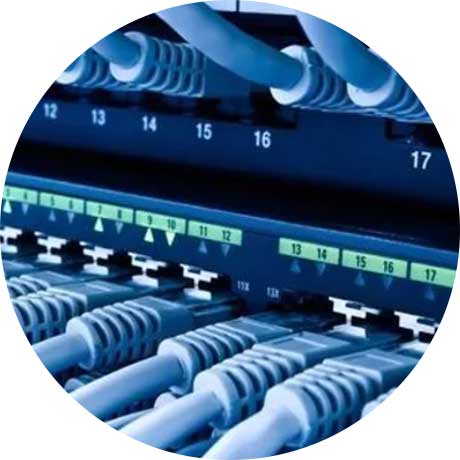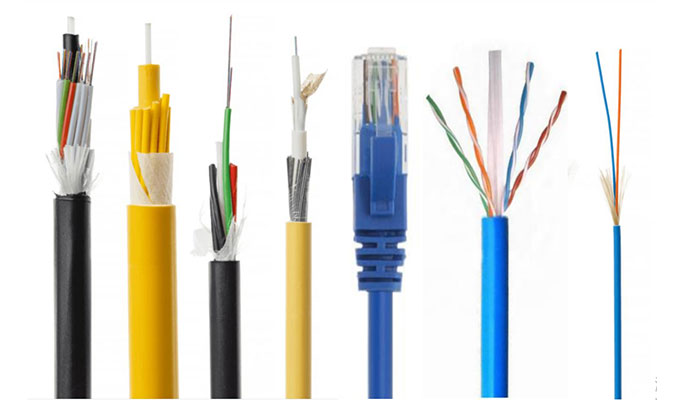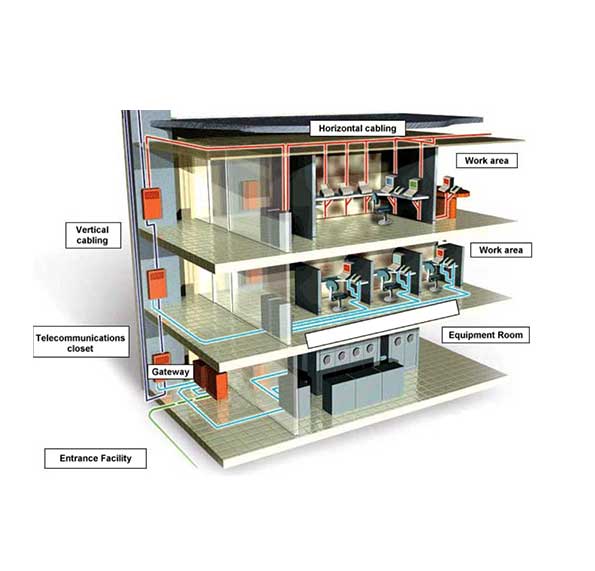
Copperled Structured cabling solution provides a new unified system building facility based on low-cost unshielded (UTP) and shielded (FTP) twisted-pair cables, fiber optic cables and physical star topology. It provides an integrated, cost-effective and high-performance end-to-end connectivity solution for voice, data, video and building low-voltage control applications.
Copperled Smart Building solutions are future-oriented, flexible and modular features that enable easy obtain to the newest technology at minimal cost and in a non-disruptive way.
Copperled manufactures a complete, end-to-end solution for installing a Copper Cabling System, which includes a broad line of bulk cable, jacks, and patch panels. Copper Cabling Systems are designed to build-out from the work area to the telecom room and provides the best cable management solutions.
LEARN MORECopperled's Network Cabinet is optional from 4U to 42U in height. 800mm wide vertical cable management is included in the network rack. There are various door options for users such as tempered glass doors, tempered glass doors with vented holes, or hexagonal vented doors with locks according to users' demands.
LEARN MORESolving customers' problems and providing complete solutions are the key goals and reasons behind our international success for Copperled's Fiber Systems. Whether the application calls for high precision fiber interconnect or complex optical switching designs, Copperled's engineers are capable of solving and/or developing fiber optic systems solutions for your applications.
LEARN MOREFTTX is a general term for various optical fiber communication networks. Fiber to the Home (FTTH) and Fiber to the Building (FTTB)/ Fiber to the Curb (FTTC) are the major types of FTTX.
LEARN MORE
Structured Cabling System utilizes the products regarding as the transmission medium of building voice, data, image and video etc that from Copper cabling system, cable cabling system and management cabling system and connected to the external network of the building and forms the support platform for signal communication.
Copperled structured cabling system enables the interconnection of a wide range of telecommunications and control equipment products from different suppliers. Copperled network products brings to hierarchical nodes and links in a star physical topology to facilitate installation, maintenance, and management. It makes the network move, expand and change easily without interruption.

A communication connects multiple buildings.
The room for network management and information exchange at an appropriate location in each building.
The system for Identification and recording the equipment between horizontal cabling and vertical cabling.
The cabling installed and connects between equipment room and telecommunication room in the building.
The cabling connects telecommunications room and socket used in the working area in the floor.
With multiple network interfaces, it connects between the socket of horizontal cabling to the end-user's equipment such as computer, printer and others.
A communication connects multiple buildings.
The room for network management and information exchange at an appropriate location in each building.
The system for Identification and recording the equipment between horizontal cabling and vertical cabling.
The cabling installed and connects between equipment room and telecommunication room in the building.
The cabling connects telecommunications room and socket used in the working area in the floor.
With multiple network interfaces, it connects between the socket of horizontal cabling to the end-user's equipment such as computer, printer and others.
We all know that structured cabling systems are composed of different areas, and cables are the most important part of them. Each of these cables has a different purpose. The standard specifies how the actual cables are laid out in the system, but one of the advantages of doing so is to make them easier to identify.
The type of cable that your structured system will use depends on your needs. They can be made of copper or fiber and have different specifications. The following are some of the main cable types used in structured cabling systems. Copperled mainly provides you with optical fiber cables and twisted pairs. For more details, please contact sales@copperled.com directly.

Structured cabling system is a network cabling solution for organizing infrastructure. The beauty of structured cabling is that it can accommodate any new hardware you add while supporting more and more data that your business uses every day, helping your business face the future. As your business grows, it makes things easier to manage!
Structured Cabling Standards mainly have 3 types as follows:
a. At the end of 1995, EIA/TIA 568 was officially updated to EIA/TIA /568A.
b. At the same time, the International Organization for Standardization (ISO) issued the corresponding standard ISO/IEC 11801.
c. EN 50173 belongs to European wiring standard.
A structured cabling system is an assembly of different components that, provide the optimum infrastructure for a wide range of business communication uses. Structured cabling companies make up this assemblage of 6 subsystems, each with their specific function. The 6 structured cabling subsystems include: Horizontal Cabling, Vertical Cabling, Entrance Facility Structured Cabling, Consolidation Point Structured Cabling, Telecommunications Enclosure and Work Area Components.

With the in-depth development of global social informatization and economic internationalization, information network system is becoming more and more important. It has become the most important infrastructure of a country and an important symbol of a country's economic strength. Structured cabling wiring is the "nervous system" of information network system with below advantages:
The structured cabling system will be able to adapt to the development of modern and future communication technology and realize the unified transmission of voice, data communication and other signals.
Structured cabling system can meet the requirements of all kinds of applications, that is, any information point can connect different types of terminal equipment, such as telephone, computer, printer, computer terminal, electric fax machine, all kinds of sensors and image monitoring equipment.
In addition to the horizontal cable fixed in the building, there are some connectors in the structured cabling system, which are standard components of the basic type. They can interconnect all voice, data, image, network and building automation equipment for easy use, relocation, change, expansion and management.
The structured cabling system is expandable so that new equipment can be easily added to it when it becomes more useful in the future.
The use of structured cabling system can reduce the management cost, at the same time, because of the modular structure, the difficulty of work greatly reduced the cost caused by the change or relocation of the system in the future.
It can adapt to all kinds of computer and network topologies in line with international communication standards and communication requirements of different transmission speeds. It can support and accommodate the operation of a variety of computer networks.

